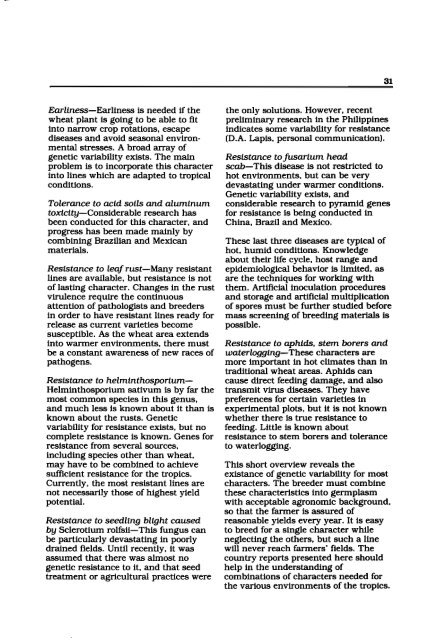the Symposium on Wheats for More Tropical Environments - cimmyt
the Symposium on Wheats for More Tropical Environments - cimmyt
the Symposium on Wheats for More Tropical Environments - cimmyt
- No tags were found...
Create successful ePaper yourself
Turn your PDF publications into a flip-book with our unique Google optimized e-Paper software.
31Earliness-Earliness is needed if <str<strong>on</strong>g>the</str<strong>on</strong>g>wheat plant is going to be able to fitinto narrow crop rotati<strong>on</strong>s. escapediseases and avoid seas<strong>on</strong>al envir<strong>on</strong>mentalstresses. A broad array ofgenetic variability exists. The mainproblem is to incorporate this characterinto lines which are adapted to tropicalc<strong>on</strong>diti<strong>on</strong>s.Tolerance to acid soils and aluminumtoxicity-C<strong>on</strong>siderable research hasbeen c<strong>on</strong>ducted <strong>for</strong> this character. andprogress has been made mainly bycombining Brazilian and Mexicanmaterials.Resistance to leaf rust-Many resistantlines are available. but resistance is notof lasting character. Changes in <str<strong>on</strong>g>the</str<strong>on</strong>g> rustVirulence require <str<strong>on</strong>g>the</str<strong>on</strong>g> c<strong>on</strong>tinuousattenti<strong>on</strong> of pathologists and breedersin order to have resistant lines ready <strong>for</strong>release as current varieties becomesusceptible. As <str<strong>on</strong>g>the</str<strong>on</strong>g> wheat area extendsinto warmer envir<strong>on</strong>ments. <str<strong>on</strong>g>the</str<strong>on</strong>g>re mustbe a c<strong>on</strong>stant awareness of new races ofpathogens.Resistance to helminthosporiumHelminthosporium sativum is by far <str<strong>on</strong>g>the</str<strong>on</strong>g>most comm<strong>on</strong> species in this genus.and much less is known about it than isknown about <str<strong>on</strong>g>the</str<strong>on</strong>g> rusts. GeneticVariability <strong>for</strong> resistance eXists. but nocomplete resistance is known. Genes <strong>for</strong>resistance from several sources.including species o<str<strong>on</strong>g>the</str<strong>on</strong>g>r than wheat.may have to be combined to achievesufficient resistance <strong>for</strong> <str<strong>on</strong>g>the</str<strong>on</strong>g> tropics.Currently. <str<strong>on</strong>g>the</str<strong>on</strong>g> most resistant lines arenot necessarily those of highest yieldpotential.Resistance to seedling blight causedby Sclerotium rolfsii-This fungus canbe particularly devastating in poorlydrained fields. Until recently. it wasassumed that <str<strong>on</strong>g>the</str<strong>on</strong>g>re was almost nogenetic resistance to it. and that seedtreatment or agricultural practices were<str<strong>on</strong>g>the</str<strong>on</strong>g> <strong>on</strong>ly soluti<strong>on</strong>s. However. recentpreliminary research in <str<strong>on</strong>g>the</str<strong>on</strong>g> Philippinesindicates some variability <strong>for</strong> resistance(D.A. Lapis. pers<strong>on</strong>al communicati<strong>on</strong>).Resistance tofusarium headscab-This disease is not restricted tohot envir<strong>on</strong>ments. but can be verydevastating under warmer c<strong>on</strong>diti<strong>on</strong>s.Genetic variability exists. andc<strong>on</strong>siderable research to pyramid genes<strong>for</strong> resistance is being c<strong>on</strong>ducted inChina. Brazil and Mexico.These last three diseases are typical ofhot. humid c<strong>on</strong>diti<strong>on</strong>s. Knowledgeabout <str<strong>on</strong>g>the</str<strong>on</strong>g>ir life cycle. host range andepidemiological behavior is limited. asare <str<strong>on</strong>g>the</str<strong>on</strong>g> techniques <strong>for</strong> working with<str<strong>on</strong>g>the</str<strong>on</strong>g>m. Artificial inoculati<strong>on</strong> proceduresand storage and artificial multiplicati<strong>on</strong>of spores must be fur<str<strong>on</strong>g>the</str<strong>on</strong>g>r studied be<strong>for</strong>emass screening of breeding materials ispossible.Resistance to aphids. stem borers andwaterlogging-These characters aremore important in hot climates than intraditi<strong>on</strong>al wheat areas. Aphids cancause direct feeding damage. and alsotransmit virus diseases. They havepreferences <strong>for</strong> certain varieties inexperimental plots. but it is not knownwhe<str<strong>on</strong>g>the</str<strong>on</strong>g>r <str<strong>on</strong>g>the</str<strong>on</strong>g>re is true resistance tofeeding. Little is known aboutresistance to stem borers and toleranceto waterlogging.This short overview reveals <str<strong>on</strong>g>the</str<strong>on</strong>g>existance of genetic Variability <strong>for</strong> mostcharacters. The breeder must combine<str<strong>on</strong>g>the</str<strong>on</strong>g>se characteristics into germplasmwith acceptable agr<strong>on</strong>omic background.so that <str<strong>on</strong>g>the</str<strong>on</strong>g> farmer is assured ofreas<strong>on</strong>able yields every year. It is easyto breed <strong>for</strong> a single character whileneglecting <str<strong>on</strong>g>the</str<strong>on</strong>g> o<str<strong>on</strong>g>the</str<strong>on</strong>g>rs, but such a linewill never reach farmers' fields. Thecountry reports presented here shouldhelp in <str<strong>on</strong>g>the</str<strong>on</strong>g> understanding ofcombinati<strong>on</strong>s of characters needed <strong>for</strong><str<strong>on</strong>g>the</str<strong>on</strong>g> various envir<strong>on</strong>ments of <str<strong>on</strong>g>the</str<strong>on</strong>g> tropics.

















